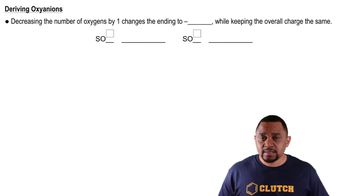Here are the essential concepts you must grasp in order to answer the question correctly.
Ionic Compounds
Ionic compounds are formed when atoms transfer electrons, resulting in the formation of positively charged cations and negatively charged anions. These oppositely charged ions attract each other, creating a stable compound. Understanding the nature of ionic bonds is essential for naming these compounds correctly.
Recommended video:
Nomenclature of Ionic Compounds
The nomenclature of ionic compounds involves specific rules for naming the cations and anions. Typically, the cation is named first, followed by the anion. For metals that can form multiple charges, such as iron or lead, the charge is indicated using Roman numerals in parentheses.
Recommended video:
Polyatomic Ions
Polyatomic ions are ions composed of two or more atoms that are covalently bonded and carry a net charge. When naming ionic compounds that include polyatomic ions, it is important to recognize the specific names of these ions, as they differ from simple anions. This knowledge is crucial for accurately naming compounds like those containing sulfate or phosphate.
Recommended video:
Polyatomic Ion Variations
 Verified step by step guidance
Verified step by step guidance

